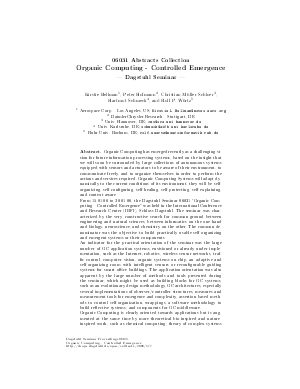06031 Abstracts Collection – Organic Computing – Controlled Emergence
Authors Kirstie Bellman, Peter Hofmann, Christian Müller-Schloer, Hartmut Schmeck, Rolf P. Würtz
-
Part of:
Volume:
Dagstuhl Seminar Proceedings, Volume 6031
Part of: Series: Dagstuhl Seminar Proceedings (DagSemProc) - License:
 Creative Commons Attribution 4.0 International license
Creative Commons Attribution 4.0 International license
- Publication Date: 2006-05-19
File

PDF
DagSemProc.06031.1.pdf
- Filesize: 187 kB
- 19 pages
Document Identifiers
Subject Classification
Keywords
- Emergence
- self-organization
- self-configuration
- self-healing
- self-protection
- self-explaining
- context-awareness
Metrics
- Access Statistics
-
Total Accesses (updated on a weekly basis)
0Document
0Metadata
Abstract
Organic Computing has emerged recently as a challenging vision for future information processing systems, based on the insight that we will soon be surrounded by large collections of autonomous systems equipped with sensors and actuators to be aware of their environment, to communicate freely, and to organize themselves in order to perform the actions and services required. Organic Computing Systems will adapt dynamically to the current conditions of its environment, they will be self-organizing, self-configuring, self-healing, self-protecting, self-explaining, and context-aware. From 15.01.06 to 20.01.06, the Dagstuhl Seminar 06031 ``Organic Computing – Controlled Emergence'' was held in the International Conference and Research Center (IBFI), Schloss Dagstuhl. The seminar was characterized by the very constructive search for common ground between engineering and natural sciences, between informatics on the one hand and biology, neuroscience, and chemistry on the other. The common denominator was the objective to build practically usable self-organizing and emergent systems or their components. An indicator for the practical orientation of the seminar was the large number of OC application systems, envisioned or already under implementation, such as the Internet, robotics, wireless sensor networks, traffic control, computer vision, organic systems on chip, an adaptive and self-organizing room with intelligent sensors or reconfigurable guiding systems for smart office buildings. The application orientation was also apparent by the large number of methods and tools presented during the seminar, which might be used as building blocks for OC systems, such as an evolutionary design methodology, OC architectures, especially several implementations of observer/controller structures, measures and measurement tools for emergence and complexity, assertion-based methods to control self-organization, wrappings, a software methodology to build reflective systems, and components for OC middleware. Organic Computing is clearly oriented towards applications but is augmented at the same time by more theoretical bio-inspired and nature-inspired work, such as chemical computing, theory of complex systems and non-linear dynamics, control mechanisms in insect swarms, homeostatic mechanisms in the brain, a quantitative approach to robustness, abstraction and instantiation as a central metaphor for understanding complex systems. Compared to its beginnings, Organic Computing is coming of age. The OC vision is increasingly padded with meaningful applications and usable tools, but the path towards full OC systems is still complex. There is progress in a more scientific understanding of emergent processes. In the future, we must understand more clearly how to open the configuration space of technical systems for on-line modification. Finally, we must make sure that the human user remains in full control while allowing the systems to optimize.
Cite As Get BibTex
Kirstie Bellman, Peter Hofmann, Christian Müller-Schloer, Hartmut Schmeck, and Rolf P. Würtz. 06031 Abstracts Collection – Organic Computing – Controlled Emergence. In Organic Computing - Controlled Emergence. Dagstuhl Seminar Proceedings, Volume 6031, pp. 1-19, Schloss Dagstuhl – Leibniz-Zentrum für Informatik (2006)
https://doi.org/10.4230/DagSemProc.06031.1
BibTex
@InProceedings{bellman_et_al:DagSemProc.06031.1,
author = {Bellman, Kirstie and Hofmann, Peter and M\"{u}ller-Schloer, Christian and Schmeck, Hartmut and W\"{u}rtz, Rolf P.},
title = {{06031 Abstracts Collection – Organic Computing – Controlled Emergence}},
booktitle = {Organic Computing - Controlled Emergence},
pages = {1--19},
series = {Dagstuhl Seminar Proceedings (DagSemProc)},
ISSN = {1862-4405},
year = {2006},
volume = {6031},
editor = {Kirstie Bellman and Peter Hofmann and Christian M\"{u}ller-Schloer and Hartmut Schmeck and Rolf W\"{u}rtz},
publisher = {Schloss Dagstuhl -- Leibniz-Zentrum f{\"u}r Informatik},
address = {Dagstuhl, Germany},
URL = {https://drops.dagstuhl.de/entities/document/10.4230/DagSemProc.06031.1},
URN = {urn:nbn:de:0030-drops-5777},
doi = {10.4230/DagSemProc.06031.1},
annote = {Keywords: Emergence, self-organization, self-configuration, self-healing, self-protection, self-explaining, context-awareness}
}
